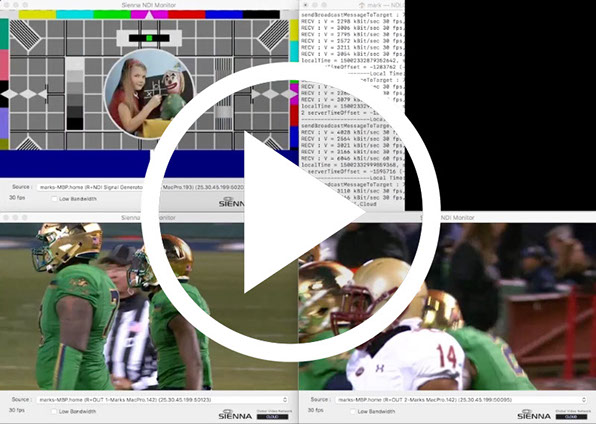
CLOUD for NDI
global ip video network
Cloud Blog #3
Testing very low bandwidth connections
Todays experiments are to test multicam performance over very low bandwidth connections using the NDI proxy mode to reduce the image size of the sources before sending over the cloud.
Low Bandwidth Challenges
Whilst its possible to set very low data rates for full HD sources in NDI.Cloud you may typically hit a couple of issues. The first is simply image quality - a very low detail fairly static video source might look quite good, but if you have more detail and lots of motion you are likely to experience significant artifacts at very low data rates.
The other issue is encoding errors - the quality of NDI.Cloud sets the bar pretty high for image quality and you may see VBV Underflow errors in the log with corresponding image deterioration if you set the data rate at a level which is much too low for the video content you are feeding.
Solutions for Low Bandwidth Video
Assuming you can't simply increase the video data rate to solve these challenges, Cloud for NDI has a couple of other options you can use :-
DISABLE AUDIO :
If your sources are video-only you can disable audio completely in the NDI.Cloud Node Gateway Preferences. Note here that there is now a preference (which should be ON dy default) to limit your audio to the first 2 channels found in the NDI stream. Many NDI Streams (eg from TriCaster) will typically have 4 channels of audio, and more often than not the second pair is unused, so you will want to avoid carrying them across the connection. Only uncheck this preference if you really want all the audio channels in the NDI Source to be carried.
ENABLE "NDI Proxy" mode in the NDI.Cloud setup for your node:
This will use the smaller size (but same quality) component of the Source NDI feeds and use those as the input rather than the full raster NDI component. In many cases the NDI Proxy is quite appropriate for remote delivery since the image quality is the same as the master NDI feed - it's just a smaller raster - downconverted from the HD original. Using the NDI Proxy allows Cloud for NDI to use a low data rate without excessive artifacts and without hitting underflow errors in the encoder.
We have seen some really great results running 3 streams at just over 3mBit/s each across a very ordinary internet connection which is capable of 10-12 mBit/s uplink. The image quality and smoothness was surprisingly good - who would have thought it was possible to get 3 great looking *synchronised* video feeds across the internet with around half a second latency between a pair of NDI devices in 10mBit/s.
About now you are probably itching to see what it looks like, so here is a video of what we saw. Bear in mind that this was a screen capture into H.264 which has then been resized and encoded again into H.264. It still looks pretty good, I am sure you will agree.
NB: This video is hosted on a server in the UK. If you are having trouble playing it, there is a copy on Vimeo HERE although the quality is not as good.

Conclusion
Cloud for NDI offers a great deal of flexibility and control when wrangling low bandwidth data connections. Learning to interpret the status information in the web interface and appreciating the tools at your disposal to optimise use of the connection will give NDI.Cloud users maximum utility from a limited connection.
When data rate is limited, don't try to squeeze Full HD down the line at poor quality - Good quality Standard Definition video is much nicer to watch than highly artifacted glitchy HD video, so make your settings appropriate for the environment.